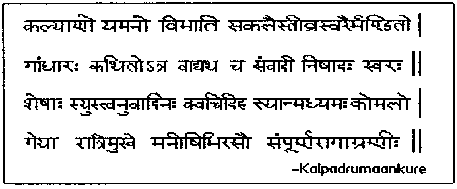This rag is considered one of the most important in all of Hindustani sangeet. It is the primary rag in Kalyan. It is a primary that. Its importance can easily be seen in the fact that it is one of the first rags to be taught. Indeed many traditions teach it even before Bilawal that.
Its origins are obscure. There is a tendency to ascribe it to Persian origins, however this is doubtful for several reasons. The first evidence is to be found in its ancient and very secure position in carnatic sangeet. It is known as “Kalyani” in this system. The second and most important piece of evidence is the fact that it appears to be modally identical to one of the old Jatis (A brief discusion of Jati may be found at “Modes and Scales in Hindustani and Carnatic Sangeet”). Thus, when one realizes that this modal form existed in Greek music (Hypolydian mode), and music of the middle east, it would be easy to ascribe this mode to proto-IndoEuropean origins. If this is the case, we are talking of a scale which antedates the concept of raga by several thousand years. Therefore rag Yaman could simply have evolved from this ancient mode with essentially no change.
The structure of Yaman is quite simple. It has all shuddha swars except for the tivra Ma. It is this note which gives the rag its distinctive quality of peace, and tranquility. The absence of the shuddha Ma also means that it will not harmonically fight for a strong tonic position. Many say that the vadi is Ga and the samavadi is Ni. This rag has a strong association with the evening.(Click HERE for a discusion of the timings of rag.)

The relationship between Yaman and the shuddha swar saptak (Bilawal), is not restricted just to early musical training. They are also closely related by the process of murchana. Yaman will be produced if one takes the madhyam of Bilawal and begins the scale from there. This is convenient for many harmonium players because his rag can be played entirely on the white keys.

However some things are not entirely clear with this rag. There is considerable debate as to the very nature of its existance. On one hand, we have a large and growing number of modernists who consider Yaman, Yaman-Kalyan, and Kalyan to be one rag. On the other hand we have a shrinking number of traditionalists who view them as three distinct ragas. Bhatkhande himself appears to have taken a middle view of Yaman being the main rag with only Yaman-Kalyan being distinguished by the addition of a weak shuddha Ma.
Regardless of our views on these theoretical arguments, it is apparent that this rag is going to be here for a long time to come.
Selected Video
Other Sites of Interest
Indian Classical Music: Tuning and Ragas
Modes and Ragas: More Than just a Scale
Emotional responses to Hindustani Raga music: The role of musical structure
Automatic Raga Recognition in Hindustani Classical Music
Patrick Moutal. A Comparative Study of Selected Hindustānī Rāga-s based on Contemporary Practice
Automatic Tonic Identification in Indian Art Music: Approaches and Evaluation

